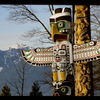Exploring University of British Columbia area of Vancouver
Julian Worker
Surrounded by lush rain forest, the campus of the University of British Columbia (UBC) protrudes into the Pacific Ocean. Most of the Point Grey peninsula is given over to the Pacific Spirit Regional Park, an area of Pacific red cedar. Some 34 trails meander for over 50 kilometres through this park. When hiking here, you wouldn't believe you are only half an hour's drive from downtown Vancouver. These trails are popular with dog walkers, joggers, and mountain bikers, but their presence won't detract from the sense of tranquility that prevails. Birdwatchers may see blue herons and will definitely hear woodpeckers hammering away.
The Museum of Anthropology is an Arthur Erickson-designed museum that is located on the cliffs of Point Grey, overlooking English Bay and the North Shore Mountains. It is probably Canada's most memorable museum, housing one of the world's finest and most colourful displays of Northwest Coast First Nations art. Inside the soaring glass and concrete structure of the Great Hall, with its 14-metre high windows that allow natural illumination to flood into the interior, you will see the totem poles, feast dishes, and canoes of the Gitxsan, Haida, and Coast Salish peoples amongst others. The museum also features the world's largest collection of works by acclaimed Haida artist Bill Reid, including his most famous sculpture "The Raven and the First Men." The award-winning Koerner Gallery within the museum houses a collection of European ceramics unique to North America. The museum also has around 15,000 objects from around the world that are accessible to the public in the Visible Storage Galleries. This is a unique way of displaying artifacts that invites the comparing and contrasting of objects from different cultures around the world, without visitors touching the exhibits, which are held in glass drawers.
Outside, in the area between the museum and the cliff, you will find totem poles of the Kwakiutl, Haida, and Gitxsan people as well as two Haida houses, one for the living and one for the dead. From here you get a good view of the main building of the museum, a unique design if ever there was one. If you like Erickson's architectural style, you may be interested in visiting the Burnaby Mountain campus of the other major university in Vancouver, Simon Fraser University, whose main buildings were also designed by Erickson.
The Nitobe Memorial Garden is an authentic Japanese tea garden where visitors can stroll past waterfalls, rivers, islands, and mountains. The highlights are the delightfully pruned maples and cherries, and of course all paths lead to the teahouse. The cherry blossoms in April or May and the iris blooms in June are spectacular. The UBC Botanical Gardens and Centre for Plant Research was established in the 1960s and is a 70-acre coastal forest with plants from temperate regions around the world. For rhododendron fans, the Asian Garden features more than 400 species, while traditional gardeners will enjoy the physic garden for medicinal herbs, which is planted around a sundial in a geometric design. The Food Garden attracts many visitors simply because of the name, and I think some people are genuinely disappointed that it contains espaliered fruit trees and the latest varieties of vegetables. In the autumn a week-long apple tasting festival is held here. The E.H. Lohbruner Alpine Garden is the largest alpine garden in North America. The UBC Rose Garden was completed in 1994 and is on top of an underground car park. On a clear day, you can see the mountains along Howe Sound for miles. From the Rose Garden the campus stretches along tree-lined roads with a pleasing mixture of older and newer buildings. One of these is the Chan Centre for the Performing Arts, a beautiful theatre that holds regular concerts of classical music featuring distinguished artists from around the world.
At the very tip of the Point Grey peninsula lies Wreck Beach. This is Canada's largest nude beach and the only one in the Lower Mainland. The path to this unspoiled strand is down hundreds of steps and to get there you have to take Trail 6 on the UBC Campus near Gate 6. The beach is very private and has a slight drug culture reputation. If you approach UBC from Kitsilano via the coastal road, you will pass Jericho Beach, Locarno Beach, and Spanish Banks, three beaches that are popular with windsurfers and kayakers and are famous locally for their extreme low tides that provide long stretches of sandy play space.
Featured Articles
Surrounded by lush rain forest, the campus of the University of British Columbia (UBC) protrudes into the Pacific Ocean.
Stanley Park is the result of remarkable foresight. In 1886 the newly-created Vancouver city council petitioned the...
While high-end boutiques figure prominently in some Montreal neighborhoods, there are entire streets brimming with bargains.
Nanaimo - VI's second largest city is also known as Harbour City. You can hike, bike, bungy and kayak here.
Vancouver tourist information is located at Centre Plaza Level, 200 Burrard St. (604) 683-2000.
USA/Canada Hostels Guide
hostels, maps, tours, money saving tips, free things to do... GET YOUR FREE COPY.
Featured Articles
Surrounded by lush rain forest, the campus of the University of British Columbia (UBC) protrudes into the Pacific Ocean.
Stanley Park is the result of remarkable foresight. In 1886 the newly-created Vancouver city council petitioned the...
While high-end boutiques figure prominently in some Montreal neighborhoods, there are entire streets brimming with bargains.
Nanaimo - VI's second largest city is also known as Harbour City. You can hike, bike, bungy and kayak here.
Vancouver tourist information is located at Centre Plaza Level, 200 Burrard St. (604) 683-2000.
USA/Canada Hostels Guide
hostels, maps, tours, money saving tips, free things to do... GET YOUR FREE COPY.



